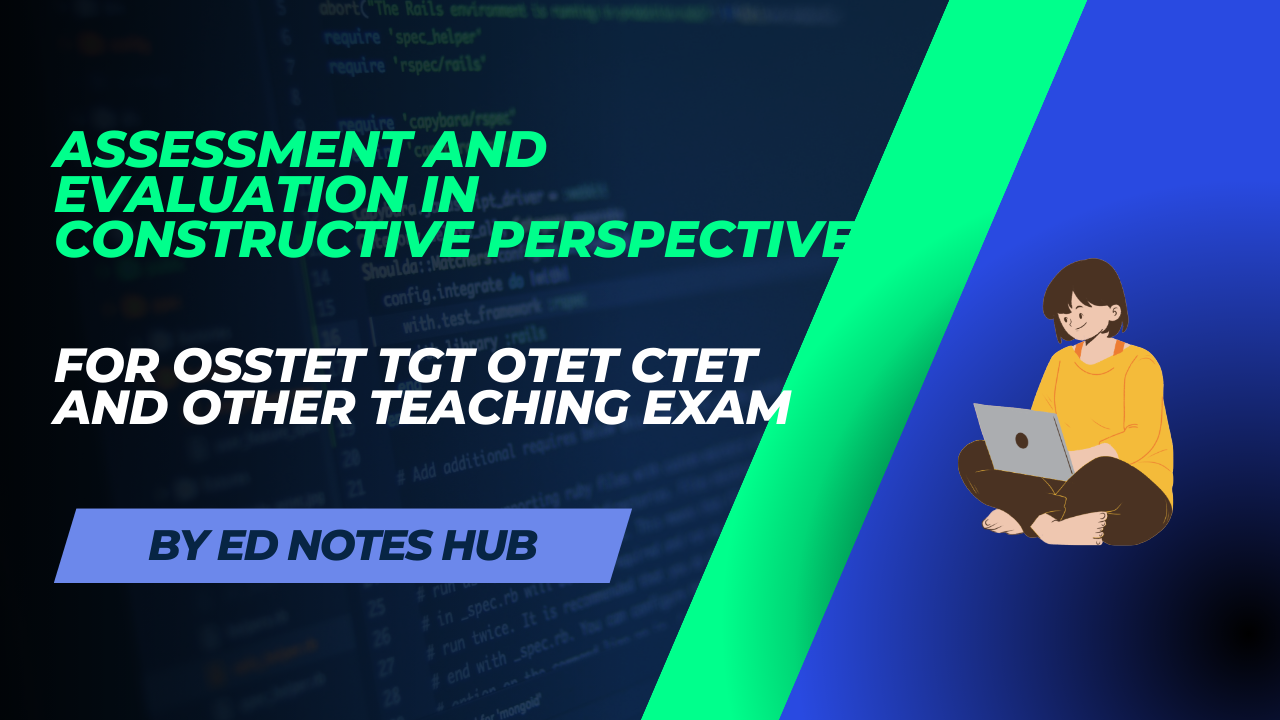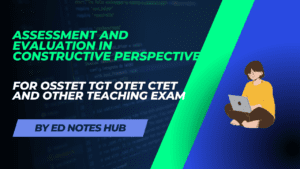Physical Address
304 North Cardinal St.
Dorchester Center, MA 02124
Physical Address
304 North Cardinal St.
Dorchester Center, MA 02124


ASSESSMENT AND EVALUATION IN CONSTRUCTIVE PERPECTIVE BEST NOTES 2024 BY EDNOTEHUB FOR YOU

Constructivism transforms the learner from a passive recipient of information to an active participant in the learning process. The learners construct knowledge of their own experiences. Constructivism is often associated with pedagogic approaches that promote active learning or learning by doing. Assessment in constructivism should provide continuous feedback to learners about their learning progress and how it can be enhanced further. In constructivism the process of gaining new knowledge is viewed as being just as important as the product.
▪ Assessment and learning: inextricably linked.
▪ Assessment is a two-way process.
▪ Assessment includes higher order skills (Analyze, create, predict, evaluate)
▪ Assessment is integrated throughout the curriculum.
▪ Assessment is situation based.
▪ Immediate feedback is given.
▪ Improves teaching learning process.
▪ Assess true potential of learners.
▪ Daily routine activities can be used to assess (discussions, observations etc.)
▪ Interaction between assessment and learning.
▪ Dialogue between assessor and assessed.
▪ Non-judgmental (purpose is not to judge the students).
▪ Continuous assessment to construct new understanding and acquire requisite skills.
▪ Measures the achievement of the learner.
▪ Measures the process skills of the learner.
▪ Provides feedback to the learner.
▪ The feedback created by the assessment process serves as a direct foundation for further development.
▪ Formative assessment helps the teacher to plan and provide new learning experiences to the Learner According to their individual needs.
▪ To diagnose the weakness of the learner and to provide appropriate remedial learning experiences.
▪ To assess and evaluate the creativity and problem-solving abilities of the learner.
▪ To monitor student’s growth and promote growth.
▪ To promote growth in cognitive aspects.
▪ To promote the development of social, emotional aspects of the child.
▪ To develop the psychomotor skills of the learner.
ASSESSMENT AND EVALUATION IN CONSTRUCTIVE PERPECTIVE BEST NOTES 2024 BY EDNOTEHUB FOR YOU
▪Assessment is not just for the sake of assigning some marks or grades for student learning but to improve And strengthen student learning.
▪A constructivist approach to assessment is formative rather than summative. Its purpose is to improve the Quality of student learning.
▪Assessment is context-specific and ongoing.
▪Assessment is a collaborative process.
▪ Evaluation focuses on how a learner can learn new material by linking it with previous knowledge andThe ability of the learner to apply it in new situations.
▪Opportunities for self-assessment and reflection should be given to the learner.
Concept Map, Portfolio and Rubrics can be used as assessment tools in constructivism teaching learning Environment.
Concept Map-Concept mapping is one way to help student’s link new ideas to knowledge they already Have. They allow a learner to explore an idea and its relationship with other concepts.
Portfolio-Portfolio is a type of tool by which different aspects and skills of a student can be assessed
Which are otherwise not possible in traditional assessment. A portfolio is a purposeful collection of student Work that exhibits the student’s efforts, progress or achievements in one or more areas. The collection Must include student participation in selecting contents, the criteria for judging merit and evidence of the Student’s self- reflection (Paulson FL, Paulson PR and Meyer, C)
Rubric-Rubric is a scoring guide used to evaluate the quality of students constructed responses. Rubrics Usually contain evaluative criteria, quality definitions for those criteria at particular levels of achievement And a scoring strategy. A scoring rubric is an attempt to communicate expectations of quality around a Task. Rubricalso provides basis for self- evaluation, reflection and peer review. Rubric improve student Performance by clearly showing the student how their work will be evaluated and what is expected.
ASSESSMENT AND EVALUATION IN CONSTRUCTIVE PERPECTIVE BEST NOTES 2024 BY EDNOTEHUB FOR YOU
Self assessment: Self assessment is an assessment which allows students to assess their own performance. lf assessment helps students to evaluate the quality of their work, identify their strengths and weakness And modify their work accordingly.
Peer assessment: Peer assessment is the assessment of student by other students. In Peer assessment Students take the responsibility of assessing the work of their peers based on assessment criteria. It Encourages students to critically reflect upon each other’s work and give constructive feedback.Some other assessment strategies include:
➢Individual And Group Projects
➢Observations
➢Oral Discussions
➢ Journal
Evaluation is a broader term than measurement and assessment it is more comprehensive than measurement and assessment
James M Bradfield
According to James am Bradfield evolution is the assignment of symbol stop phenomenon in order to characterise the worth of value of a phenomenon usually with reference to some social cultural or scientific standards
N.E GRONLUND AND R.L.LINN
Evaluation is a systematic process of collecting analysing and interpreting information to determine the extent to which pupils are achieving instructional objectives , evaluation includes both quantitative description and qualitative description along with value judgments.
It Must Be Clearly Stated What Is To Be Evaluated
A Teacher Must Be Clear About The Purpose Of Evaluation He Must Formulate The Instructional Objectives And Define Them Clearly In Terms Of Student Observable Behaviour.
It Variety Of Evaluation Techniques Would Be Used For A Comprehensive Evaluation
It is not possible to evaluate all the aspects of achievement with the help of a single technique for the better revelation the techniques like objective dates as a test observational test should be used and evaluated for know the limitations of different evaluation techniques
Evaluation can be done with the help of simple observation of highly developed standardised tests but whatever the instrument of technique may be it has its own limitations there may be measurement errors sampling errors error also found due to incorrect interpretation update scores.
The Techniques Of Evaluation Must Be Appropriate For The Characteristics Of Performance To Be Measured
Every Evaluation technique is appropriate for some huge and an appropriate for other therefore while selecting an evolution technique one must be well aware of the strength and limitation of this technique.
Evaluation Is A Means To An End But Not An End It Self
The evaluation technique is used to take decisions about the learner it is not merely gathering data about the learner because blind collection of data is wastage of both time and effort
There Are Four Type Of Evaluation
Placement evaluation
Formative evaluation
Diagnostic evaluation
Summative evaluation
The placement evaluation is designed to measure entry performance of the pupils. the main purpose of the placement evolution is to place the right person in the right place the future success of the instructional process depend on the success of the placement evaluation , because it choose the person with the right aptitude and attitude for a particular instruction .
Formative evaluation is used during the teaching learning process , it helps the student and teacher to identify the immediate learning difficulties on the basis of this a teacher can provide feedback to the student and to himself head back to the student eliminate the learning errors and write reinforcement for successful learning feedback to other teacher helps to modify the methods of instruction and to prescribed remedial works . It enables the teacher to assess the relevance and appropriateness of the learning experiences provided and to evaluate instantly how far the goals are being fulfilled.
The three type of functions of formative evaluation they’re
Diagnostic functions
Placement functions
Monitoring function
Diagnostic evaluation is used when corrective measures prescribed on the basis of formative evaluation fails to solve the problems. Diagnostic evolution is an essential tool for a teacher it can be used to diagnose strengthened areas of the needs of students it involves the gathering and careful evolution of detailed data age student knowledge skin into keeping learning area.
Diagnostic evaluation is used for learning were taking actions to adjust teaching plays significant role in improving learning outcomes for all students diagnostic evolution is also provides A deeper level of insight than surface level observation.
Diagnostic evaluation is more comprehensive and detailed than that formative evaluation in order to diagnose the learning difficulties it uses specially design diagnostic tests and various observational techniques.
When the learning difficulties are acute in that case services of psychotherapist psychological tests and psychologists are required the main objective of the Evaluation is to determine the causes of the persistent learning problems that remain unsolved.
Summative Evaluation is used to determine how far the instructional objectives have been achieved it obviously comes at the end of the course. summative evaluation is used to evaluate student learning skills acquisition an academic achievement at the conclusion of a defined instructional period. Typically at the end of your project, course, semester or school year.
summative evolution is characterised as assessment of learner where as formative evaluation is assessment for learning.
The main objective of this summative evaluation is to assign grades to the pupils. it indicates the degree to which the student had mastered the course, The result of summative evaluation are used as student permanent academic record.
Certifying: summative evaluation accord the grades which factored into students a permanent Academy record to be used in the future for admission to an institution or to entertain job.
Promoting: it is results whether to promote or not promote student to next higher classes
Diagnosite: submitted evaluation and may be used for identify any areas of weakness for further investigation through formative evaluation .
Summative evaluation is a high stake type of assessment for the proposal making final judgement about student achievement and instructional effectiveness.
When it occurs student have typically accepted the learning mode.
It forms a terminal point that sums up the performance over learning level of achievement
Continuous And Comprehensive Evaluation CLICK HERE
ADRESSING CLASSROOM DIVERSITY click here